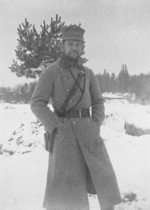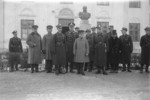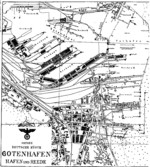
Poland
| Full Name | 14 Republic of Poland | |
| Alliance | Allies - Minor Member Nation or Possession | |
| Entry into WW2 | 1 Sep 1939 | |
| Population in 1939 | 34,775,000 | |
| Military Deaths in WW2 | 400,000 | |
| Civilian Deaths in WW2 | 5,200,000 | |
| - Civ Deaths from Holocaust | 3,000,000 |
Contributor: C. Peter Chen
ww2dbaseOn 11 Nov 1918, at the end of WW1, Poland returned to the map of Europe for the first time for 123 years. Józef Pilsudski, who ruled Poland from 1918 until his death in 1935, quickly established rather effective legal, transportation, administrative, and military systems under a dictatorial regime.
ww2dbaseEconomically, Poland had a relatively prosperous 1920s, but the global depression of the 1930s hit the country rather hard, especially considering the rapid population growth. The conservative government spending habits did little to increase the monetary supply in the Polish economy, though the Polish government did develop very advanced socialist programs.
ww2dbaseDuring the inter-war years, Poland's greatest achievement was in the realm of foreign policy. Pilsudski laid out a careful circle of friends in the diplomatic arena, first allying with France to restrain Germany from the thought of invasion from the west, then allied with neighboring Hungary and Romania to discourage aggression from the Soviet Union in the east. In 1932, Poland signed a non-aggression treaty with the Soviet Union that calmed relations and reduced the incidents on the eastern border. In 1934, a similar treaty was signed with Germany to reduce tension and to normalize trade. On the surface, this seemed to have eased German's frustration with East Prussia having been separated from Germany Proper after the creation of Poland.
ww2dbaseMilitarily, the Polish Navy was small but strong enough to counter a modest attack from the Baltic Sea, the Polish Air Force was highly advanced with the world's only all-metal air fleet, and the Polish Army was unified and enjoyed high prestige. However, as the 1930s went on, politicians who controlled the armed forces, despite top leadership's military origins, did not effectively manage the build-up to its maximum potential during peace time, and the Polish military fell behind its neighboring counterparts as quickly as it had grown.
ww2dbaseTo bolster diplomatic and military efforts, the Polish dedicated many resources to the field of intelligence. As early as the early 1930s, Polish mathematicians from the University of Poznan cracked German and Soviet military codes, therefore the Polish military was able to monitor military deployments of the two neighboring powers.
ww2dbaseAs Europe moved toward war, Czechoslovakia and Poland drew closer in the face of the potential common enemy, Germany. The two countries negotiated toward an alliance where Poland would gain partial ownership of the Skoda weapons plants for the promise that Poland would come to the aid of Czechoslovakia should a German invasion take place. When Germany annexed Czechoslovakia, however, Poland turned on its ally and took part in the partition of the country, capturing a small piece of eastern Czechoslovakia (the territory of Treschen and the nearby Bohumin rail junction) in Mar 1939. Although Germany and Poland had been debating over the Danzig issue, Poland did not realize Germany would soon turn on Poland until it was too late.
ww2dbaseOn 1 Sep 1939, after a series of purposefully-made unacceptable ultimatums, German troops poured across the Polish border after staging a bogus border incident. The Polish forces fought back fiercely, outperforming the German Army in the few occasions where the two forces were evenly matched. The more modernized and mobile German military, with ample air support, made those situations rare, however, by simply out-maneuvering the Polish forces. On 5 Sep, Poland moved its military headquarters to southeastern Poland, with the intention of allowing its top generals to continue the fight while northern Poland was being overrun. This prolonged the war gave allied France and the United Kingdom more time to launch a counterattack against Germany (which would never happen), but it also created much confusion between the political and military leaders, making the defense effort uncoordinated. The prospect of French and British intervention and the Polish military's ability to inflict high casualties against the oncoming Germans gave Poland some hope, but the optimism took a decisive hit when the Soviet Union invaded from the east on 17 Sep 1939. Poland surrendered on 28 Sep, and coordinated military resistance ceased by the first week of Oct.
ww2dbaseAfter the conquest, Eastern Poland was occupied by Soviet forces. Western Poland was annexed by Germany. Central Poland was governed by a German military government. Economically, the occupation forces looted Poland, with the Germans taking large portions of the produce without regard to the starvation of the people, while the Soviets uprooted Polish industries and relocated them to the east. Politically, the Soviets planted intrigue and fostered violence between Jews and ethnic Ukrainians, while the Germans did the same between Christians and Jews. Both sides created slave labor from the population, while leaving the conquered and dismembered country to suffer starvation and disease.
ww2dbaseIn Jun 1941, Germany invaded the Soviet Union, and eastern Poland became one of the first battlefields. As the Soviet occupiers fled east, the German Einsatzgruppen units moved in immediately after them. Polish towns and villages that had survived the Soviet NVKD now faced German mobile killing squads. These squads systematically rounded up Jews, potential political opponents, and even innocent civilians for detention or massacre. Throughout the WW2 period, German mass killings, particularly against Jews, increased in efficiency and ruthlessness. The most infamous was the use of gas chambers, which began at the Auschwitz Concentration camp in occupied Poland on 3 Sep 1941. Within months, entire trains were dedicated to bringing Jews and other unwanted peoples for extermination.
ww2dbaseMany groups of armed Polish resistance existed during the war. The group that posed the greatest threat to the German and Soviet occupiers was the Home Army (Armia Krajowa). The AK, which absorbed smaller resistance groups, was more so a secret underground government than a mere guerrilla force. In addition to having a military chain-of-command, it also maintained schools, industries, radio stations, and publishing services for the Polish people. The military wing of the AK initially opposed frequent confrontations with German forces in order to preserve strength, particularly with the brutal retribution attacks on civilians in mind. That restraint was lifted on 1 Aug 1944 as Soviet troops neared Warsaw. Although the Polish still held the Soviets, the AK thought the Soviet troops would, at least temporarily, ally themselves with the Polish resistance fighters for the common goal of removing German forces from Warsaw. When Warsaw would become liberated, AK leaders would then be able to claim legitimacy for being those who liberated the capital. Resistance fighters rose up as ordered against great odds, destroying German armored vehicles and killing many occupation soldiers. Adolf Hitler, furious, ordered the occupation force to systematically level entire sections of Warsaw until the city was nothing more than a pile of rubble. As the fighting continued and Polish resistance strength slowly waned, Soviet forces stood by. Furthermore, the Soviet Union even refused the Western Allies from using Soviet air bases to mount supply operations for the Polish resistance. As the Germans brutally quelled the uprising, Joseph Stalin's intentions were, belatedly, crystal clear. Tactically, the Soviets were letting the Germans to expend ammunition and lives. Strategically, Stalin, who had a puppet regime for post-war Poland already in mind, saw this as an opportunity to remove future political opposition.
During the occupation between 1939 and 1945, an estimated 5,200,000 civilians died as a direct result; that number alone was staggering without needing to stress the fact that it amounted to 15% of the 1939 population of Poland.
ww2dbaseThe liberation of Poland by the Soviet Union was a repeat of the 1939 conquest. The Soviets once again looted all they could from Poland, and the people starved. As the Western Allies turned a blind eye to the Soviet treatment of Poland, the AK fell apart without western support. Polish border was redrawn as Stalin pleased. Eastern Poland, conquered by the Soviets during the 1939 invasion, was annexed. To justify the territorial loss, the Allies granted Poland eastern portions of Germany. The border changes resulted in forced population relocations, which led to further human suffering. With a Moscow-backed puppet government in place in Warsaw, Poland remain independent in name only until the end of the Cold War.
ww2dbaseSources:
John Radzilowski, A Traveller's History of Poland
William Shirer, The Rise and Fall of the Third Reich
Last Major Update: Jun 2007
| Events Taken Place in Poland | ||
| The Danzig Crisis | 24 Oct 1938 - 29 Aug 1939 | |
| Operation Peking | 29 Aug 1939 - 1 Sep 1939 | |
| Invasion of Poland | 1 Sep 1939 - 6 Oct 1939 | |
| Gestapo-NKVD Conferences | 27 Sep 1939 - 31 Mar 1940 | |
| Operation Barbarossa | 22 Jun 1941 - 30 Sep 1941 | |
| Warsaw Ghetto Uprising | 19 Apr 1943 - 16 May 1943 | |
| Erntefest Massacre | 3 Nov 1943 - 4 Nov 1943 | |
| Operation Kutschera | 1 Feb 1944 | |
| Operation Frantic | 2 Jun 1944 - 22 Sep 1944 | |
| Operation Bagration | 22 Jun 1944 - 29 Aug 1944 | |
| Discovery of Concentration Camps and the Holocaust | 24 Jul 1944 - 29 Apr 1945 | |
| Warsaw Uprising | 1 Aug 1944 - 2 Oct 1944 | |
| Vistula-Oder Offensive | 12 Jan 1945 - 2 Feb 1945 | |
| Silesian Offensive and the Siege of Breslau | 8 Feb 1945 - 6 May 1945 | |
| East Pomeranian Offensive | 24 Feb 1945 - 4 Apr 1945 | |
| Aircraft | ||||
| PZL.11 | PZL.23 Karaś | PZL.24 | PZL.37 Łoś | PZL.7 |
| Ships | ||||
| Błyskawica | Garland | Orzel | ||
| Burza | Grom | S-25/Jastrzab | ||
| Vehicles | ||
| 4TP | PZInz 130 | TKS |
| 7TP | Samochód pancerny wz.34 | |
| C7P | Sokól 1000 | |
| Weapons | ||
| Blyskawica Submachine Gun | Karabin przeciwpancerny wzór 35 Anti-Tank Rifle | Vis Handgun |
| Facilities | ||
| Auschwitz Concentration Camp | Prison Camp | |
| Belzec Concentration Camp | Prison Camp | |
| Chelmno Concentration Camp | Prison Camp | |
| Deutsche Werke Gotenhafen | Shipyard | |
| Majdanek Concentration Camp | Prison Camp | |
| Sobibór Concentration Camp | Prison Camp | |
| Treblinka Concentration Camp | Prison Camp | |
Photographs
 |  |  |  |
 |